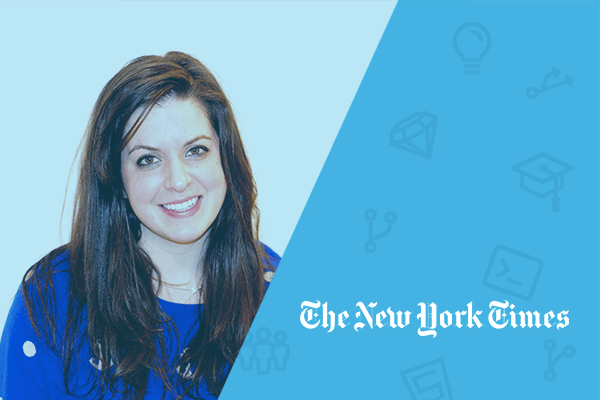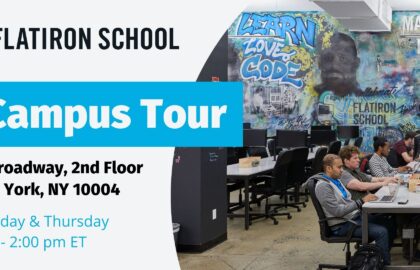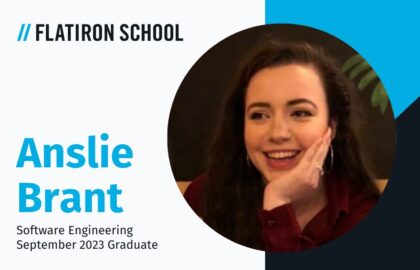In our Beyond the Bootcamp series, we chat with members of our alumni community about their post-Flatiron career journeys. What new roles have they taken on? How did they get to where they are now? What advice do they have for new programmers following in their footsteps?
Tiffany Peon went to Berklee College of Music, receiving a degree in Music Business. Finding that the music industry wasn’t in the best place for job seekers, Tiffany went into tech, moving through customer service, account management, and project management roles before learning to code at Flatiron School. She’s now a Software Engineer at The New York Times. Read on to hear more about Tiffany’s unique journey to programming, the similarities between music and coding, and her advice for future developers.
Learning to code
After college, Tiffany says she “fumbled around for a while” before starting to work in tech, where she quickly discovered that her favorite part of the day was when she worked with the developers on her team. “It was problem solving; it was creating creative thinking,” she says. “I felt that when I was working with developers I got a little bit of that same creative spark that I felt when I was in music school. Whereas everything else that I was doing kind of felt like drudgery, so I decided to learn how to code and see what it would be like to be a developer.”
As it turned out, there were more similarities between coding and music than she initially thought – pattern recognition, creativity, problem solving. According to Tiffany, there’s also “that same feeling of working on something over and over and over again and feeling like you’re never going to get it – and then this great high you get, when you finally get something to work.”
Takeaway #1 – Without a technical background, Tiffany admits to being nervous approaching learning to code and reinventing her career. “I hadn’t been in a math class for probably eight or nine years,” she says, “so I had a lot of people telling me, ‘You know that’s really hard; you’re going to need to know math; I can’t imagine changing careers at your age’ – things like that. But I’d tell anyone who is doubting themselves to just jump in. It is never going to be a bad thing to know how to code. Even if you end up moving into product, or you go somewhere totally different with your life after the fact, it’s a skill that is applicable to pretty much anything.”
The Flatiron School Experience
Tiffany had been in the process of enrolling in a post-bacc program at NYU to get up to speed so she could apply to do a masters in Computer Science. “I didn’t really know any other way and I wasn’t interested in going back to undergrad because I’d only been out of school for about three years,” she says. “But as I was going through the process, mapping out what my life would be like and all the costs and loans I would need to take out, someone recommended Flatiron School to me. I thought it seemed like a less risky thing to take these three months off of work and to just go ahead and get started in the career.” She quickly went from feeling burnt out in her current job to remembering what it’s like to not just be in school but “to be really passionate about what you’re doing.” She says, “I met people from all sorts of different backgrounds, and everyone was really very caring, and kind and intelligent. It was a sort of reinvigorating experience that I don’t think you usually get in adult life.”
Tiffany’s favorite part of Flatiron School wasn’t technical exactly – it was learning how “to look at something that appears impossible and just dive head first into it.” She explains, “The experience that I had at Flatiron taught me that when you’re feeling injured, you’re feeling weak, you’re feeling like there’s no way you’re ever going to make it past this one benchmark, you’ve been here before and that this feeling of wanting to give up is exactly that moment where you’re about to break through a barrier.” That mindset has helped her with difficult projects at work and things in her personal life (congrats on the half marathon, Tiffany!). “When I look at something that sort of feels unattainable, I know that it is attainable,” she says. “it’s just going to take a lot of those moments of checking in with myself and going, ‘I’ve been here before and I’m going to get through it.’”
Takeaway #2 – Tiffany’s advice for prospective Flatiron students? Embrace struggling through a problem – and learn how to Google things! “With everything I’ve faced going up the ranks of my developer career, there are new problems that no amount of school or prior experience could have prepared me for – it’s more the knowledge that yes you are going to struggle for a little while, you are going to have to ask for help. I think Flatiron does a really good job of making you understand that experience, while humbling, is not limiting and doesn’t mean that you are any less capable than anyone else around you at solving problems.”
Life at The New York Times
Six days after graduating from Flatiron, Tiffany accepted an apprenticeship at email marketing platform Constant Contact. She became the first developer under the company’s tech lead to begin developing two brand new rails apps for their first foray into social media advertising. Tiffany calls it a dream experience: “I got to do what we would be doing at a startup (or what we were doing at Flatiron for our student projects), but instead I was doing it for this company at scale.” She was hired after her apprenticeship there to take on the project, seeing it through its initial launch and several other spin offs of the project over the course of her two years there.
It was around a year and half into her time at Constant Contact that she began talking to The New York Times. “I’d gotten to know a few people who worked here through some Ruby conferences and Twitter and Slack,” she says, “and I started talking to the person who is now my manager seven months before I actually received a job offer. The project that I work on is The New York Times cooking app – it’s an app that I’ve been using since it launched and I’ve always been a big fan. So when I heard there was an opening, I talked to them and sort of just waited until things fell into place. They eventually came back and said there’s an opening for this now, if you’d like to apply.”
As part of the beta division at The New York Times, Tiffany’s team operates like a little startup within the company. The cooking application takes about 15,000 recipes from the New York Times food section and digitizes them. “I work heavily with design, editors, product, marketing, as well as, eight other engineers, front-end, back-end and iOS to develop new features for both the iPhone app which I support as a back-end engineer, and then for the website itself,” she says. The biggest surprise she encountered there: “How much I loved being a developer and how creatively fulfilled I feel. I kind of thought that I would go into product or something like that after a few years as a developer, but I’ve actually discovered how happy I am just doing what I do.”
Takeaway #3 – Tiffany’s top advice for coding bootcamp grads launching a new career is to “listen to whatever your career advisors at Flatiron say. If they tell you to take the job, take the job even if doesn’t seem like your dream job” – noting how she leveraged her experience at Constant Contact to get that dream job at the Times. “If they tell you to change something, change the way that you’re doing something. They have a lot more knowledge about what they’re doing than what you know, and even if it seems like weird or counterintuitive, there’s a reason for it – so just give it a shot.”
What’s next for Tiffany?
“Here at the Times, we have a more technical path,” she says. “So my goals for the next few years are to just get better at both my technical skills and also at seeing the big picture – so working towards things like Senior Developer or an architect or a tech lead.”
Ready to start your own programming journey? The best way to get started is our free Bootcamp Prep course. Stay tuned for more installments of “Beyond the Bootcamp”!




